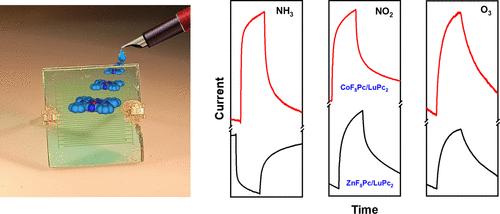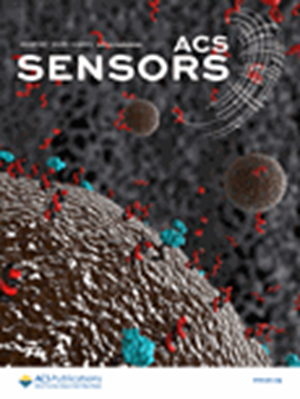Ambipolar 异质结传感器:检测污染气体的另一种方法
IF 9.1
1区 化学
Q1 CHEMISTRY, ANALYTICAL
引用次数: 0
摘要
基于双极材料的气体传感器在缩小分析系统尺寸和提高分析系统效率方面具有显著优势。本文利用不同的八氟酞菁配合物(以 Zn 和 Co 为金属中心),结合双酞菁镥配合物(LuPc2),构建了双层异质结器件。ZnF8Pc/LuPc2 器件在电子捐献(NH3)和氧化(NO2 和 O3)两种气体中均表现出稳定的 p 型行为,而 CoF8Pc/LuPc2 器件在还原气体中表现出 n 型行为,在氧化气体中表现出 p 型行为。Co 基器件的大部分电荷载流子的性质因目标气体的性质而异,表现出一种两极行为。这两种异质结器件在亚ppm范围内对所有三种有毒气体都表现出稳定和可观察的响应。值得注意的是,钴基器件对氨气高度敏感,检测限(LOD)为 200 ppb,而锌基器件对氧化性气体异常敏感,对 NO2 和 O3 的检测限分别为 4.9 和 0.75 ppb,这使其成为迄今为止报道的对氧化性气体最有效的有机异质结传感器之一。本文章由计算机程序翻译,如有差异,请以英文原文为准。

Ambipolar Heterojunction Sensors: Another Way to Detect Polluting Gases
Gas sensors based on ambipolar materials offer significant advantages in reducing the size of the analytical system and enhancing its efficiency. Here, bilayer heterojunction devices are constructed using different octafluorinated phthalocyanine complexes, with Zn and Co as metal centers, combined with a lutetium bisphthalocyanine complex (LuPc2). Stable p-type behavior is observed for the ZnF8Pc/LuPc2 device under both electron-donating (NH3) and -oxidizing (NO2 and O3) gaseous species, while the CoF8Pc/LuPc2 device exhibits n-type behavior under reducing gases and p-type behavior under oxidizing gases. The nature of majority of the charge carriers of Co-based devices varies depending on the nature of target gases, displaying an ambipolar behavior. Both heterojunction devices demonstrate stable and observable response toward all three toxic gases in the sub-ppm range. Remarkably, the Co-based device is highly sensitive toward ammonia with a limit of detection (LOD) of 200 ppb, whereas the Zn-based device demonstrates exceptional sensitivity toward oxidizing gases, with excellent LOD values of 4.9 and 0.75 ppb toward NO2 and O3, respectively, which makes it one of the most effective organic heterojunction sensors reported so far for oxidizing gases.
求助全文
通过发布文献求助,成功后即可免费获取论文全文。
去求助
来源期刊

ACS Sensors
Chemical Engineering-Bioengineering
CiteScore
14.50
自引率
3.40%
发文量
372
期刊介绍:
ACS Sensors is a peer-reviewed research journal that focuses on the dissemination of new and original knowledge in the field of sensor science, particularly those that selectively sense chemical or biological species or processes. The journal covers a broad range of topics, including but not limited to biosensors, chemical sensors, gas sensors, intracellular sensors, single molecule sensors, cell chips, and microfluidic devices. It aims to publish articles that address conceptual advances in sensing technology applicable to various types of analytes or application papers that report on the use of existing sensing concepts in new ways or for new analytes.
 求助内容:
求助内容: 应助结果提醒方式:
应助结果提醒方式:


